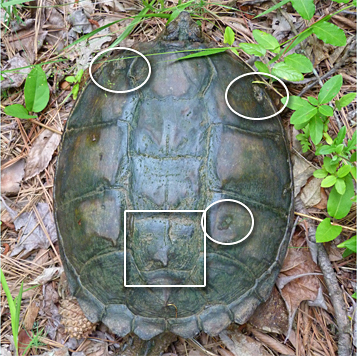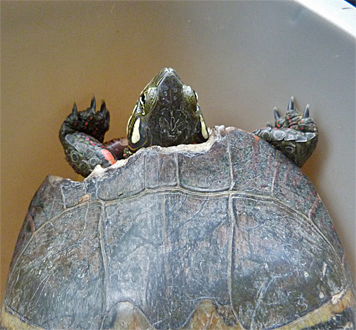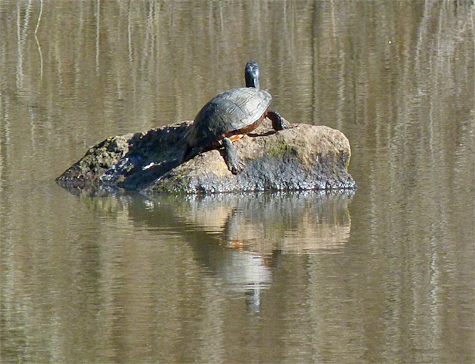I’ve been watching turtles here at the Museum since my arrival some 6 years ago. We have about five species in our Wetlands: Yellow-bellied Slider, Red-eared Slider, Eastern Painted, Eastern Musk, and Common Snapping Turtles. You might be thinking, “Hey, what’s he talking about, you either have five species or you don’t,” and you’d be right. The reason I say about five species is because the red-eared is not native. I haven’t seen any adults that I can definitely call red-eared, but some of the newly hatched young that I’ve picked up have red “ears.” They’re a common aquarium turtle and are often released where they shouldn’t be when those that have them don’t want them any more, so it’s not surprising that they’re here.
Back to the point, each spring and summer, usually starting in May, female aquatic turtles emerge from the water, seek out a suitable place to dig a hole and deposit white, ping pong ball eggs. For the past two years I’ve been catching the turtles that I happen to see, and that the staff here informs me of, and measuring, marking and recording bits of data about them. I write down the temperature, cloud cover, number (after marking them), carapace length (top shell), location (where found), and behavior (heading east, laying eggs, etc.). You can see more about the how and why of catching and marking turtles in two blog entries from 2012, Turtles: The Evolution of a Project – Part 1 and Turtles: The Evolution of a Project – Part 2, but here I want to report some of what I’ve seen.
So far, I’ve captured and marked the following:
17 Yellow-bellied Sliders (YBSL)
3 Eastern Painted Turtles (EAPA)
3 Eastern Musk Turtles (EAMU)
2 Common Snapping Turtles (COST)
That’s twenty-five turtles, the vast majority of which are yellow-bellied. This is not surprising since on any given day in spring and summer you’re likely to see many more YBSLs out basking than any other turtle in our wetlands, there’s more of them. What is interesting is that five of those YBSLs were caught in the act of laying eggs (I waited for them to finish before marking them) and two of them looked to have just completed laying eggs, their legs and the rear of their shells were wet and muddy (laying eggs is a muddy business). The smallest YBSL was 9 1/4″, the largest 11 7/8″ from the notch at the front of the carapace to the notch at the rear of the carapace (the measurement method I used was something called CCLmin or Minimum Curved Carapace Length).
There have been 43 encounters with turtles (not including the ones that got away), 18 of which have been repeat encounters with turtles that I had already marked. Three of the YBSLs were first captured in 2012 and recaptured in 2013 in the same locations that they were captured the previous year. This suggest that once they find a safe and secure location to lay eggs they come back (of course, this is only two years of data, we’ll have to wait to see what the next few years tell us).

A few of the YBSLs were observed in two different locations on the same day. Some were encountered on two consecutive days in different areas of the Museum property. However, the master of the wandering turtles is Chip, a turtle that is known to most here at the museum since her carapace has a large chunk missing from its left side. On one day in June of 2013, the 3rd to be exact, she was seen on the far side of the outdoor exhibit loop just past Catch the Wind. The next day she was down near the restrooms in Explore the Wild. The day after that she was up on the service road leading to the train tunnel. And finally, ‘ol Chip was seen hustling down the path on the Dinosuar Trail on the 6th of June. She gets around.

Speaking of Chip, she was once observed laying eggs in May of 2011 in Catch the Wind. So yes, she does get around.
I didn’t mark the two COSTs simply because I’m usually by myself when marking turtles and don’t want to loose any fingers in the process. Each of the two captured had markings on their shells which were unique to them so it shouldn’t be difficult to ID them if seen again. I was able to measure and photograph both snappers.

Eastern Musk Turtles, or Stinkpots, are small turtles and don’t often bask out in the open. And, they can be easily overlooked while they’re out hunting for a nesting spot. The smallest of the three captured was only 3 7/8″, the largest was 4 3/4″ in length.

I caught 3 Eastern Painted Turtles. Interestingly, two of them had physical damage. One of the EAPAs had one eye and a piece of its tail missing. The other EAPA had parts of its carapace missing, the marginal scutes at the front of its shell were damaged. It’s difficult to say how this occurred to the turtles but it will be interesting to see if I find more painteds with physical damage. Are painted turtles too slow getting away from predators, too passive, are they clumsy, or did I just happen to run into two unlucky painteds?

I don’t capture every turtle that wanders out of the water looking to nest. I’m not here every day, and I’m certainly not here at sunrise when many of them are making their first ventures out of the water, so I’m bound to miss much of the action. And, as I alluded to earlier, two years of data is a very small sampling of what’s going on with our aquatic turtles. But, I’m already seeing a hint of nest site fidelity in some of the turtles. And, the more data that’s collected the more likely patterns will emerge from that data. So, with that thought in mind, I’m looking forward to next spring, not just for the warmth, but for the day when the turtles again begin to come ashore looking for nest sites. I’ll be ready for them.

How many months till May?
Your collection permit is all set for 2014 Greg. Good Luck!
I cannot wait to see Chip again.